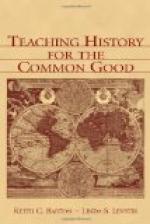Specific suggestions on formulating questions
In order to do this the examination must be on the really material considerations of the history. Questions on unimportant details should be omitted. The student should not be expected to burden his memory with the limitless mass of petty isolated facts contained in the average history text. The questions should be on considerations that have been carefully discussed, and not on facts that have received but cursory attention.
The examination should not require too much time for writing. The several hours’ continuous nervous tension sometimes exacted by too ambitious teachers does the average child more harm than the examination can possibly do him good.
The examination should consist of questions that will jointly or severally test the student’s powers of description, generalization, and analysis. They should test his knowledge of the sequence of events, his ability to use a library or a map, his knowledge of the various phases and the various periods of the history studied. In every examination there should be at least one question dealing with the time and the order of events, one each on the geographical, political, and social history, one that is analytical, one that requires generalization, one that will test his knowledge of the library, and one that will test his powers of description. It is not necessary to limit the questions to the customary number of ten. It is frequently advisable to give a class some degree of choice in the selection of their questions by requiring any ten out of a larger number asked. Certainly such a plan gives the student a more favorable opportunity to demonstrate his ability without in the least diminishing the value of the examination.
Examination questions, like all other questions, should be definite, clean-cut, and reasonable. If possible, each student should be supplied with a copy, instead of having the set written on the board. They should cover only those portions of the subject that have been properly taught. The teacher should not expect the boy who has kept no useful notes, whose library work has been haphazard, and whose methods of study have not been supervised, to perform at examination time the miracle of accurately remembering what he has never been properly taught.
OUTLINE
I. SOME PRELIMINARY CONSIDERATIONS
1. Assumptions as to the teacher of history
2. Actual conditions confronted by the teacher
II. HOW TO BEGIN THE COURSE
1. What should be done on the day of enrollment
2. What should be done at the first meeting of the class
3. Necessity for definite instruction in methods of preparing a lesson
4. The question of note-taking
5. Instruction in the use of the library and indexes




